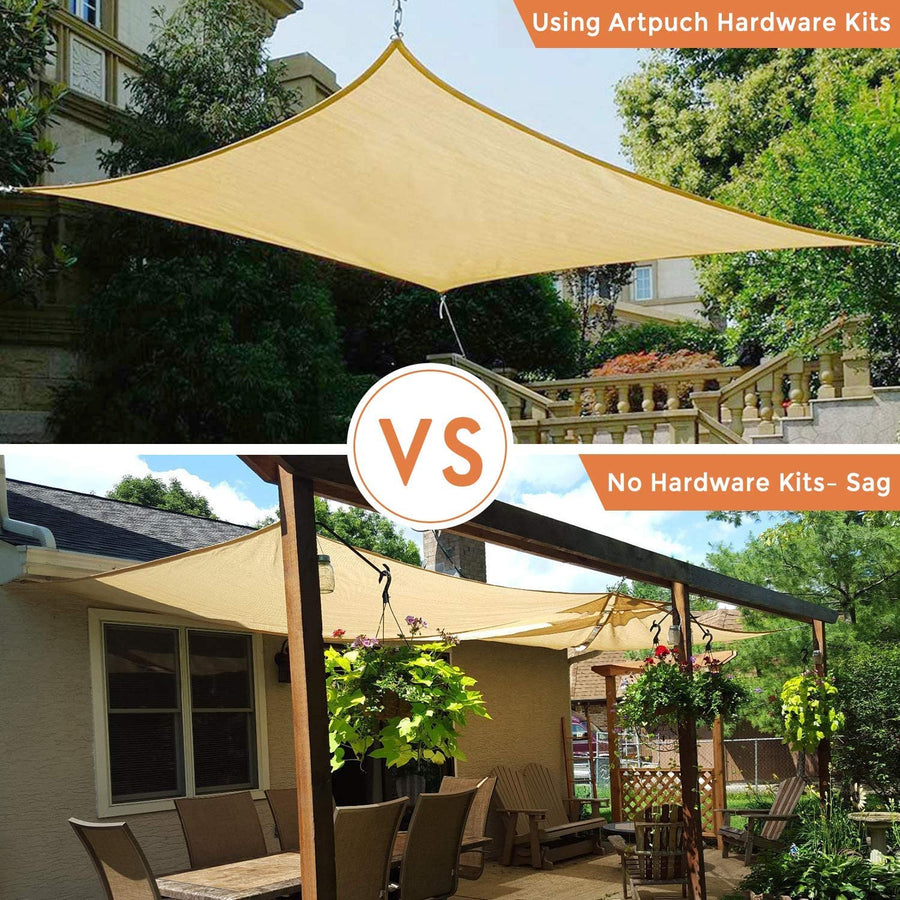Shade sails have gained immense popularity in recent years due to their ability to provide much-needed shade and aesthetic appeal in a wide range of outdoor spaces. These versatile and stylish fabric structures can transform any patio, garden, or swimming pool area into an inviting oasis. However, one crucial question that often arises when installing a shade sail is: Should shade sails be tight?
Better yet, how to make shade sail tight too? In general, you can count the fact that the perfect tension is essential for both ensuring structural integrity and maximizing the effectiveness of its sun-blocking capabilities. So, here’s everything you need to know about how much tension on shade sail is needed and how to tension a shade sail!
Benefits of Proper Shade Sail Tension
Other than keeping the shade sail secure, are there actually benefits to sail tension? Absolutely; let’s dive into some of the major benefits you can expect from strong and proper shade sail tension.
Enhanced Aesthetics
It can be fairly easily agreed that a sagging shade sail is an ugly shade sail. While the strong tension in a shade sail is to keep it strong and sturdy over time, it’s also about aesthetics too. Your outdoor living space should look gorgeous, and a sagging sail is going to instantly cheapen the look of your space.
Effective Sun Protection
One of the main reasons you’re getting a shade sail is due to blocking out the sun and staying protected from the harmful UV rays, right? Well, under-tensioning your shade sail can lead to a pretty big reduction in coverage. Overall, you’d just be defeating the entire purpose of having one.
Wind Resistance
While that cool summer breeze feels amazing, a gust of wind- not so much. So, by having proper tension, you can count on it having far better wind resistance and stability overall. The last thing you need is for one gust of wind to swoop your beloved sail away. But keep in mind that over-tension is pretty bad, too, so be sure you find that sweet spot.

Factors Influencing Shade Sail Tension
There are actually going to be a few factors that’s going to determine how tight should a shade sail be. Honestly, when it comes to adding anything in your outdoor living space, specifically something that’s going to be exposed to the elements, you can hands-down guarantee that some factors will be influencing it. So, here’s some major factors to think about.
Material and Fabric
Generally speaking, when you’re out looking and shopping around for a shade sail, you’ll have to keep in mind the two major components; material and fabric. The choice of material used in constructing a shade sail can greatly impact its durability, effectiveness, and overall appearance. Some of the most common materials used include high-density polyethylene fabric, polyester fabric, and PVC-coated fabrics. You’re going to want to get something that has a lot of strength, UV resistance, and breathability.
But not all materials/fabrics are built the same. HDP tends to fade quickly, basically being a no-go from an aesthetics perspective, while polyester offers excellent color retention and is known for its durability. PVC-coated fabrics provide resistance to harsh weather conditions. Overall, the weight of the material and as well as durability (such as the ease of ripping) is going to play a major role in how much tension can be put onto the sail shade.
Size and Shape of the Sail
Does the size and shape of a sail actually matter? Well, it’s not all in the ropes, but the shape, and especially the sizing, are going to have a major impact. This of it this way, a larger sail will provide more shade coverage, while a smaller one may be more suitable for compact spaces. Ideally, you’ll want less rope and more fabric (from a perspective of aesthetics, of course). In terms of shape, there are various options available, including rectangular, triangular, and square sails.

Something that’s not too often looked at, especially when it comes to tension, is the wind flow itself; the last thing you want is for your sail to blow away or for any damage to get done at all. So it’s crucial to decide on a shape that’s able to prevent excessive flapping from strong gusts.
Attachment Points and Hardware
You can’t expect to attach a shade sail, and it is tight if you lack the appropriate tools for attachment. These attachment points serve as the anchor for the sail, allowing it to be properly secured and stretched across the desired area. The hardware used must be durable and reliable to withstand various weather conditions (such as rusting over time), ensuring that the shade sail remains securely in place over time.
While not all attachment points are installed in existing structures such as buildings or poles, it helps if you can attach it to these because they’re able to provide a solid foundation for the shade sail. The last thing you want is sagging or even corrosion over time, so make sure you plan this out accordingly and think of the long term too.

Is Over-Tension a Bad Thing?
Sometimes too much of a good thing can be terrible, and that goes for over-tension too. Over-tensioning can cause unnecessary stress on the structure and reduce its lifespan. So, what you’ll need to keep in mind would be regular checks. Chances are, you might have to adjust the tension over time, as the fabric can stretch or contract due to temperature changes or wind loads.
What are the Common Mistakes for Sail Shade Tension?
At the end of the day, it’s about not being too tight and not being too loose, either. You need to have that sweet spot. As you’ve learned in this article, if it’s too loose, it’ll sag and essentially defeat its purpose of providing shade. If it’s too tight, then you’re increasing the chance of getting rips and the sail being deemed useless. So, be sure to find the right balance for the tension.

